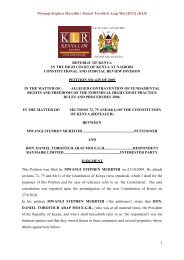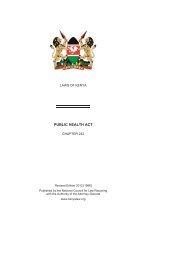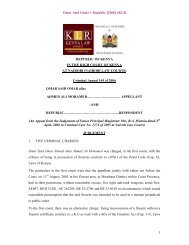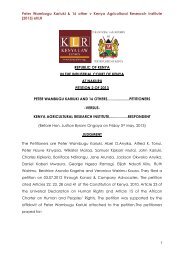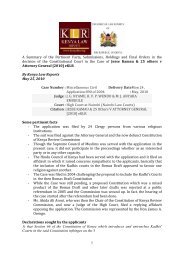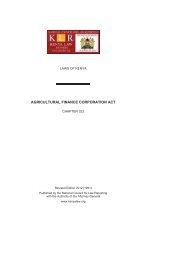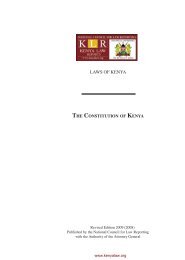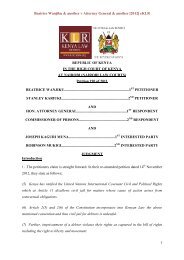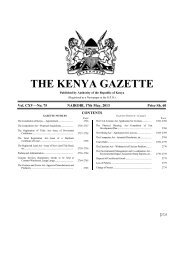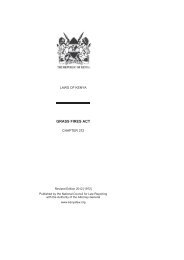Bench Bulletin - Issue 12 - Kenya Law Reports
Bench Bulletin - Issue 12 - Kenya Law Reports
Bench Bulletin - Issue 12 - Kenya Law Reports
You also want an ePaper? Increase the reach of your titles
YUMPU automatically turns print PDFs into web optimized ePapers that Google loves.
KENYA LAW REPORTS<br />
BENCH BULLETIN<br />
FROM THE COURTS — COURT OF APPEAL<br />
Corroboration of Evidence in Defilement Cases<br />
Dennis Muthee Chokera V Republic<br />
Court of Appeal, at Nyeri.<br />
S E O Bosire, E M Githinji & J G Nyamu.<br />
Criminal Appeal No. 487 of 2007<br />
June 25, 2010.<br />
Reported by Cornelius W Lupao<br />
Case History<br />
Evidence-identification-where victim identified the offender with the help of light from a hurricane lamp-whether<br />
such light could be said to be sufficient for proper identification.<br />
Evidence-corroboration-where corroborative evidence showed that the complainant was defiled despite the fact that the<br />
alleged perpetrator was not clinically examined-whether a conviction can solely be based on the corroborative evidence<br />
despite lack of clinical tests on the alleged perpetrator.<br />
Criminal Practice and Procedure - evidence- evaluation of evidence-duty of the first appellate court to evaluate the<br />
trial court’s evidence.<br />
Constitutional <strong>Law</strong> - constitutional right-allegation of violation of constitutional right-alleged violation being pleaded<br />
as an afterthought - effect of.<br />
The Hon. Mr. Justice<br />
S. E. O. Bosire<br />
This was a second appeal against conviction and sentence for the offence of defilement of a girl<br />
under the age of 16. The appellant’s main grounds of appeal were that his constitutional rights<br />
were violated since he was held in police custody for three days beyond the Constitutional<br />
limit of 24 hours as set out in section 72 of the Constitution without any explanation and<br />
therefore his trial was a nullity; that the intensity of the light from the hurricane lamp which<br />
was used by the complainant to identify him or to recognize him was not ascertained by<br />
the court and therefore there was a possibility of mistaken recognition; that the superior<br />
court erred in inferring that failure by the appellant to cross-examine some witnesses i.e<br />
PW1, PW2 and PW3 meant that the appellant was the culprit; that the superior court failed<br />
in not addressing the fact that no matching tests were conducted on the appellant and that<br />
only clinical tests were selectively done on the complainant and finally that the superior<br />
court failed to sufficiently evaluate the evidence on record hence reached a verdict that was<br />
against the weight of the evidence.<br />
On its part, the prosecution stated that the evidence presented was overwhelming; that the appellant was identified<br />
by recognition, the hurricane lamp having provided sufficient light for the purpose of identification and immediate<br />
recognition and that the appellant never raised the ground of infringement of his constitutional right in the trial court<br />
or in the superior court where he had engaged the services of an advocate. It also added that the sentence was well<br />
merited.<br />
Held:<br />
1. The alleged failure of the court to consider the intensity of the light from the hurricane lamp could not be sustained<br />
since the appellant had earlier in the day spoken to the complainant in a manner which suggested an intention to<br />
have sexual intercourse with her. The appellant had told the complainant that he was “taking cows to her mother”<br />
meaning that the appellant had designs to marry the complainant. In addition the complainant had ample opportunity<br />
to recognize the appellant.<br />
2. The allegation that the appellant did not cross-examine certain witnesses could not arise since the superior court<br />
had made reference to it and because cross-examination had formed the heart of the case before the court.<br />
3. The failure to have the appellant clinically tested, though ideal, was not fatal to the charge of defilement since the<br />
clinical evidence contained in the P3 form inter alia, confirmed penetration although the complainant was taken to<br />
the hospital long after the incident. In addition, the two courts below accepted the evidence of the complainant as<br />
true and the clinical evidence was corroborative of the complaint’s story. It did not stand alone; it was reinforced by<br />
the direct evidence of the complainant.<br />
<strong>Issue</strong> <strong>12</strong>: April-June 2010 35



